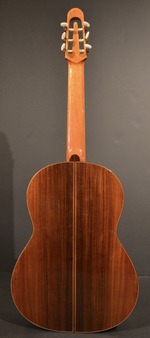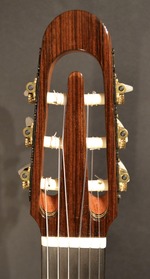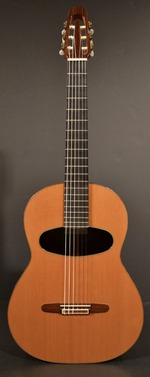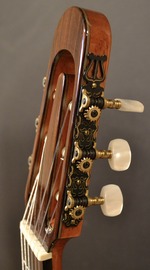Gerard AUDIRAC
"Cathedrale" 2005
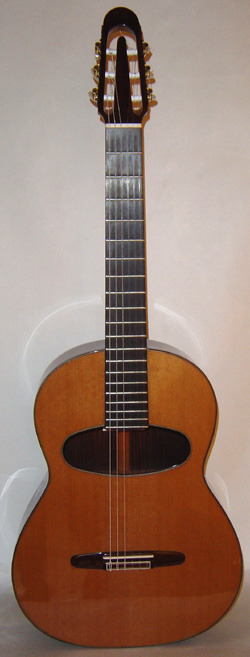 La Selle, France
La Selle, France
Western Red Cedar Soundboard, Indian Rosewood Back and Sides
Ebony fretboard with 650 string length, used, excellent condition.
$6500 SOLD
This is the Cathedrale model grand concert guitar from the hands of master luthier Gerard Audirac. This model is without question one of the most powerful guitars we have ever carried. Its revolutionary design involves an enlarged and elongated soundhole, a unique interplay of bridge and headstock and a special bracing treatment under the soundboard.
The result is a full, penetrating projection with complete clarity and balance from the lowest to the highest notes. It also possesses a rich tone and long sustain. The sensation of playing this superb instrument is somewhat like that of performing on a cathedral organ. It is designed to fill a concert hall with its mellifluous voice.
You may request an mp3 sound file of this or any other of our guitars.
France, 2001
Cedar Soundboard, Indian Rosewood Back and Sides
Ebony fretboard with 650 mm string length
SOLD
A preowned Grand Concert model with slight signs of wear but generally in excellent condition. This was the original soundhole design that Gerard Audirac created when he was searching for a more open sound in his guitars. It was nicknamed the "batman" for obvious reasons.
Interview with Gerard Audirac from the magazine GUITARE CLASSIQUE , Spring 2000
Guitare Classique: Gerard Audirac, what did you do before becoming the luthier that you are today?
Gerard Audirac: I have a grade school diploma and that?s all. At 15 I was working in a factory, and for 10 years I had a thousand and one jobs. From being a wiring specialist for a Jesuit gym teacher to a night watchman in a garage. (Laughs.) Finally I stopped, it was taking too long. I even wanted to become a teacher, in the spirit of Frenet, but my prospects in that direction were not very good and knowing my temperament I'd never be able to adapt to that profession.
How does lutherie fit into all of that?
Well, one day I took a piece of paper, I made two columns, in one column I wrote what pleased me generally in my life. But quickly, by spontaneous association. In the other column I jotted down what could provide me with a professional activity. And then I compared the two and I noticed that in the first there was the word "guitar," in the second I had written that I wanted to be free, work with my hands in something of a scientific and artistic nature. And then, in associating all of that, the profession of guitar making appeared in a flash. And that?s how it came about. Strange but true.
That's where everything started, the first contacts with the help of the phone book (that?s my thing, the phone book), the first hopes, but also the first disillusionments. And I made contact with Horace Papparlado who said to me: "Have you already worked with wood?" And I had to answer, "No." He: "What do you do?" Me: "I?m a delivery truck driver." (Laughs.) Finally the interview ended and his son, Antoine, ushered me out and asked me to leave my address and phone number.
In other words, it was a bad beginning!
That's for sure. But I was frank. And that evening my doorbell rang and I knew that it had worked. I was on trial for 15 days. And I worked like crazy. I walked miles on foot to and from the shop. I stayed more than four years with Horace Papparlado and there I had my first contact with wood.
Then I opened my own workshop at Bagnolet in a narrow alley called Fosse aux Fraises. Yet I still needed supplies because I had none, and I had very little money. Once again the sovereign phone book, this time for cabinet makers, and I called around to ask to buy old tools that had already served their purpose. So then, bingo, there I was with a workbench, a multitude of tools and a large stock of wood. And I started to make guitars.
What sort of guitars?
Oh, they were little unpretentious guitars. Besides, I didn?t know how to make anything but student guitars. I had no notion at that time of what "true lutherie" was all about. So it was just a matter of slaving away, but I held out by working hard and when you want to learn you find the means to do it, you grab on and you work hard.
I was frustrated because of my lack of real knowledge about the acoustic functions of the instrument, and my first contact with accurate information came during a seminar on fundamental research and instrument acoustics. This was the first time anyone gave me concrete answers to the problems I was having. And I also learned that all guitars work the same way, that the movement of the bridge is always the same, for example, it?s very important to know all of that. No guitar maker ever taught me that, and that?s a shame.
And so how do you make a guitar, with what concept of construction?
Well, that's very simple: when I get an idea about acoustics I first make a prototype. If I get convincing results I transform the test into a finished product for further study, in order to apply the principals to a concert guitar. And so on and so forth until I get a result that suits me. That?s how I work, and I get good results.
What is for you the essential quality of a luthier?
Imagination. But be careful, it?s necessary that that imagination be situated always in a logical and rational context. Helter-skelter guitar making where you do things by chance, that?s truly not my style.
Do you think that the guitar is an instrument that can still be improved?
Now there you touch on a sensitive point and I can?t answer that question just like that because the results of all my research are at stake and I wouldn't want to give away everything at this time. I discovered a phenomenon about seven years ago and I'm now in the process of perfecting it. It's fantastic! Yet it's something known to every luthier.
You?re being mysterious. Can we learn more about it?
No, I don't feel like talking about it. (Laughs.) If I give away the smallest detail, I might as well tell all, right? And then after all it?s my business. It?s not that I?d like to play at being mysterious but I just prefer to keep it to myself. That being said, like I said a moment ago, it?s about a phenomenon very well known to luthiers and it happens that I talk about it sometimes to young people who join the profession. It's a way of doing for them what no one ever did for me. I give them a legacy of what I know.
The only thing I could say is that it's a discovery just as important and will have as much impact as the fan bracing of Torres. And here we are in another dimension.
Okay, so we must stay in the dark. What in your opinion makes a good guitar?
That's a tricky question calling for a tricky answer. (Laughs.) I would answer, like all my colleagues, the timbre, the power?the two need not be antithetical?the trueness, the sustain, the percussiveness, a whole range of things well balanced, and that's the difficulty that the luthier faces, to balance all those parameters.
